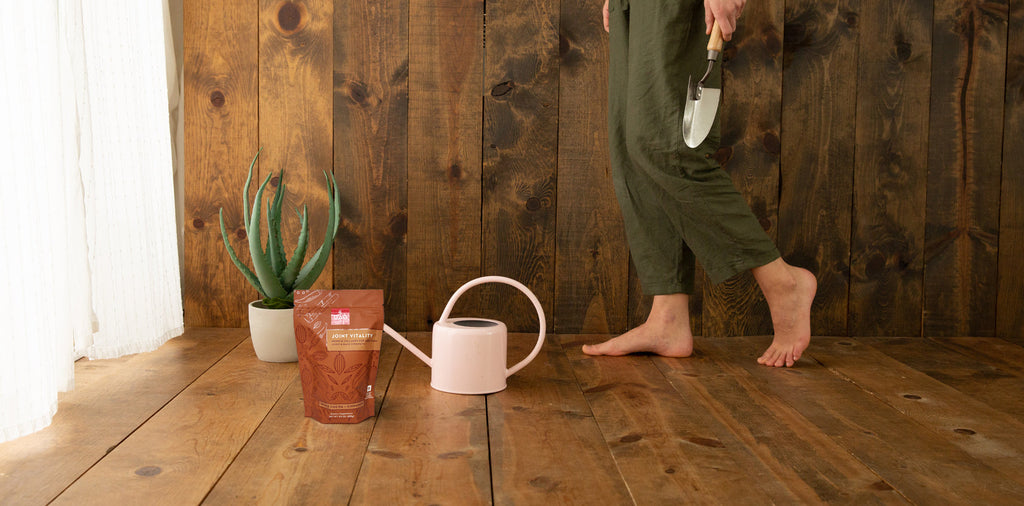The need for joint and lower back support is probably the condition that most often has us reaching for the medicine cabinet or heading to the doctor’s office. When joint support needs become chronic and debilitating, lives are altered, sometimes ruined. Taken a step further, the tragic opioid crisis that has been spiraling out of control in recent years reminds us that the biomedical answers for chronic pain are deeply flawed.
Even our milder medications, such as non-steroidal anti-inflammatory drugs (NSAIDs) like Ibuprofen, should not be taken long-term. They not only damage the stomach lining but are now known to also harm the kidneys in high doses or with sustained use, leading to loss of kidney function. Fortunately, Chinese herbal traditions provide a distinctive approach that may help maintain joint comfort and mobility. It has the potential to bring support and strength to countless individuals with little or no side effects.
DAO Labs Joint Vitality is inspired by the 7th-century formula called Du Huo Ji Sheng Tang ("Pubescent Angelica and Taxillus Decoction"). It is a unique and versatile Chinese formula that supports long-term joint health and mobility, which I regularly incorporate into my clinical practice.
In order to understand how this special blend of herbs can provide support, we need to first explore the Chinese medicine understanding behind the need for joint discomfort. At the most fundamental level, there are two causes in Chinese medicine - either the flow of Qi and Blood is obstructed, or it is insufficient. Joint Vitality is unique in the Chinese formulary in that it addresses both causes.

Easing Obstruction
Let’s first tackle the problem of obstruction. According to The Inner Canon, one of the foundational texts of Chinese medicine, the need for chronic joint support is often related to climatic factors. Put simply, “the three Qi of Wind, Cold, and Dampness combine to create a blockage.”
According to traditional Chinese medicine, external influences like Wind, Cold, and Dampness may interfere with the body’s natural energy flow, which may influence mobility and physical ease.
In the West, we are not used to thinking about climatic factors as forces injurious to our bodies. Yet, have you ever had the feeling that it was going to rain just by the feeling in your joints that day? The quality of pain will differ depending on which pathogen is primary in any particular instance of "Blockage", but more experts agree that it is important to address all three factors in most treatments.
What’s valuable about this classical teaching is how it informs traditional approaches to supporting joint function and managing occasional discomfort through herbal solutions.
Not surprisingly, roughly half the herbs found in Joint Vitality directly address these climatic factors. Siler (Fang Feng), angelica pubescent (Du Huo), and Gentiana microphylla root (Qin Jiao) work together to drive out "Wind and Dampness"; poria (Fu Ling) drains "Dampness", and cinnamon bark ("Rou Gui") powerfully warms the interior (one very important note: we do not include asarum (Xi Xin), a very warming, wind-dispersing medicinal, in our preparation, even though it is found in the original formula. It contains aristolochic acid, which is known to be a carcinogen.)
These herbs are assisted by a second set of medicinals to help move the "Blood". When blockage persists for a long time, it can in turn lead to "Blood stagnation". So this formula also contains ligusticum (Chuan Xiong), cyathula (Chuan Niu Xi), and angelica sinensis (Dang Gui) to help maintain this additional need for joint support.

Easing Deficiency
Now let’s turn to the second main reason for joint support. In addition to the pathogens above, long-term joint stiffness is also a manifestation of deeper forms of “deficiency.” When our bodies become weaker, the flow of Qi and "Blood" is less robust. On its own, this insufficiency can cause pain, but it is even more nefarious in this case, because deficiency makes us more vulnerable to the external pathogens of "Wind, Cold, and Dampness".
"Deficiency" is a concept that can be difficult for Westerners to grasp. In the case of chronic pain, it can be caused by a number of factors. First, the aging process itself will make us vulnerable. Even with careful diet and exercise, everyone’s body slows down eventually, and deficiencies inevitably arise. Second, our everyday activities, whether it's an overly vigorous exercise routine or just our mundane efforts to get through the day, can easily cause injuries. We may be only dimly cognizant of the problems when they occur. Over the years and decades, however, these injuries can add up and lead to serious deficiencies.
Fortunately, Chinese medicine has numerous medicinals to address the problem of "deficiency". In Joint Vitality, ginseng (Ren Shen), white peony (Bai Shao), and angelica sinensis (Dang Gui) all help treat deficiencies of Qi and "Blood". Other herbs, such as loranthus (Sang Ji Sheng), eucommia (Du Zhong), cyathula (China Niu Xi), and cooked rehmannia (Shou Di Huang), support healthy liver and kidney function. This last set of herbs is intriguing. In Chinese medicine, the organs are all associated with various body parts. Herbal ingredients in this formula are thought to promote flexibility and support overall musculoskeletal wellness.

A Versatile Formula to Support the Joints
The unique composition of Joint Vitality makes it a versatile formula, particularly for anyone with a recognizable deficiency manifesting in the need for chronic joint support. Who might these individuals be? Classically, the formula is said to be more appropriate for individuals who require low back and knee support. But I have found it useful for most individuals who are dealing with long-term needs, especially in the joints. These individuals may also have stiffness and numbness.
Sometimes, the need for support can be traced to past traumas, such as a car accident, a fall, a sports injury, etc. Other times, the cause may simply be the aging process. Because the supplementing medicinals in this formula also balance out the (relatively mild) harshness of the draining and dispersing herbs, it is a well-balanced formula that can generally be taken for the long term.
That’s perfect for many chronic joint needs. These conditions often develop over years and therefore take a long time to address. The good news is that this formula, when used properly, should not cause any major side effects and can lead to a gradual but meaningful improvements in the joints.

Care Consideration: Just a reminder that the above information is not a substitute for medical care and is not a substitute for medical advice or recommendations from a healthcare provider. This information is not intended to treat, mitigate, or cure any disease. That said, we encourage you to connect with an Acupuncturist in your community to learn more about this and other Traditional Chinese Medicine options. If you’ve got questions about Chinese herbal medicine or getting started with an Acupuncturist, feel free to connect with us at hello@mydaolabs.com.












,_LAc_96x96.jpg?109467)



